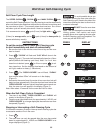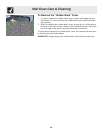
34
Wall Oven Self-Cleaning Cycle
NOTE: A smoke eliminator in the oven
vent converts most of the smoke into a
colorless vapor.
During the self-cleaning
cycle, the outside of the oven can
become very hot to the touch. DO NOT
leave small children unattended near the
appliance.
The health of some birds is
extremely sensitive to the fumes given off
during the self-clean cycle of any wall oven.
Move birds to another well ventilated room.
DO NOT line the oven walls,
racks, bottom or any other part of the
appliance with aluminum foil. Doing so will
destroy heat distribution, produce poor
baking results and cause permanent
damage to the interior (aluminum foil will
melt to the interior surface of the oven).
DO NOT force the oven door
open. This can damage the automatic door
locking system. Use caution when opening
the door after the Self-Cleaning cycle is
completed. The oven may still be VERY
HOT.
Self-Cleaning Oven
A Self-Cleaning oven cleans itself with high temperatures (well above
cooking temperatures) which eliminate soils completely or reduces
them to a fine powdered ash you can wipe away with a damp cloth.
Adhere to the following cleaning precautions:
• Allow the oven to cool before cleaning.
• Wear rubber gloves when cleaning any exterior parts of the oven
manually.
• DO NOT clean the oven door gasket. The woven material of the
oven door gasket is essential for a good seal. Care should be taken
not to rub, damage or remove the gasket.
• DO NOT use any cleaning materials on the oven door gasket.
Doing so could cause damage.
• Remove the broiler pan and insert, all utensils and any
aluminum foil. These items cannot withstand high cleaning
temperatures.
• This oven comes with lubricated porcelain oven racks, which can
remain in the oven during the self-clean cycle. Do not clean this
vegetable oil lubrication off the racks. It is important that the sides
of the oven racks always have a light coating of vegetable oil. To
maintain optimal rack performance, re-apply a thin layer of
vegetable oil to the sides of the rack after every self-clean cycle or
when the rack becomes difficult to slide.
• Remove any excessive spillovers in the oven cavity before
starting the Self-Cleaning cycle. To clean, use hot, soapy water
and a cloth. Large spillovers can cause heavy smoke or fire when
subjected to high temperatures. DO NOT allow food spills with a
high sugar or acid content (such as milk, tomatoes, sauerkraut, fruit
juices or pie filling) to remain on the surface as they may leave a
dull spot even after cleaning.
• Clean any soil from the oven frame, the door liner outside the oven
door gasket and the small area at the front center of the oven
bottom. These areas heat sufficiently to burn soil on. Clean with
soap and water.
NOTE: Prior to setting the Self-Clean cycle, any spills remaining on the
oven bottom should be removed.
Some models have an exposed Bake element in the wall oven cavity.
On these models the bake element is designed to be tilted up using
your hand from the front of the bake element. This will allow easier
access to the oven bottom for cleaning. Be careful not to raise the
element more than 4 or 5 inches from the resting position.
What to Expect during Cleaning:
While the oven is in operation, the oven heats to temperatures much
higher than those used in normal cooking. Sounds of metal expansion
and contraction are normal. Odor is also normal as the food soil is being
removed. Smoke may appear through the oven vent.
If heavy spillovers are not wiped up before cleaning, they may flame
and cause more smoke and odor than usual. This is normal and safe
and should not cause alarm. If available, use an exhaust fan during the
self-cleaning cycle.


















